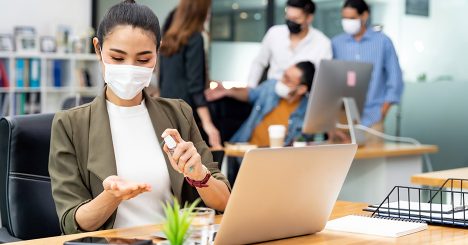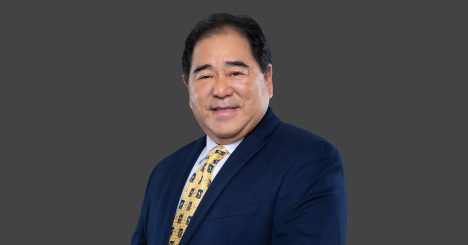With guidance regularly changing and sometimes seemingly conflicting, some misperceptions about best practices for employers during the COVID-19 pandemic still exist. Here are eight common misunderstandings and the facts employers should know.
Myth 1: Face masks or coverings won’t prevent you from getting COVID-19, so there’s no reason to encourage employees to wear them at work.
Fact: The Occupational Safety and Health Administration (OSHA) recommends that employers encourage workers to wear face masks at work because the coverings are believed to help prevent wearers who have COVID-19 (including those who are asymptomatic or presymptomatic) from spreading infectious respiratory droplets to others. There are exceptions, of course:
- Consider accommodations for workers with medical conditions that would make it unsafe for them to wear face coverings.
- Face coverings may be hazardous to wear in some workplaces. For example, for employees who work with chemicals that could attach to a cloth covering, masks may not be advisable.
While masks aren’t going to work everywhere, a policy requiring employees to wear face coverings is worth considering. News that patrons and employees of a Missouri hair salon weren’t infected with COVID-19 despite the presence of two coronavirus-positive stylists suggests face coverings can be effective. The salon was reportedly requiring staff and patrons to don masks and practice social distancing, which may have prevented patrons and coworkers from becoming infected.
Myth 2: If employees are wearing masks, we can have in-person meetings and gatherings like we did pre-COVID.
Fact: OSHA and the US Centers for Disease Control and Prevention (CDC) have made clear that face coverings are not a substitute for social-distancing measures.
The CDC’s website has suggestions for businesses on other measures that can be considered, including staggering shifts, increasing physical space between workstations, using signs or tape to indicate where to stand to maintain a 6-foot distance, postponing meetings, and limiting access to spaces where employees may congregate.
You should continue encouraging social distancing and include measures appropriate for your particular workspaces in your COVID-related policies.
Myth 3: People can become infected with coronavirus in many different places, so it would be impossible to prove an employee was infected at work.
Fact: It’s true there are many different infection sources. OSHA recognizes, however, a confirmed case of COVID-19 can be an illness employers are required to report if it is work-related and meets the agency’s recording criteria. OSHA has advised that illnesses are likely to be considered work-related when, in the absence of alternative explanations:
- Multiple employees who work closely together become ill;
- The illness occurs shortly after the employee had lengthy, close exposure to a customer or coworker who has a confirmed case of COVID-19; or
- The sick employee’s job duties involved frequent, close exposure to the general public in a location with ongoing community transmission.
Myth 4: Our company has fewer than 50 employees, so we don’t have to comply with the Families First Coronavirus Response Act (FFCRA).
Fact: All private employers with fewer than 500 employees are covered by the FFCRA and must notify employees of their rights under the Act. Compliant posters are available to download for free on the US Department of Labor (DOL) website.
Small businesses with fewer than 50 employees are exempt from providing paid sick leave and expanded family and medical leave if doing so would jeopardize their viability as a going concern. If you are considering denying leave, you should ensure you can meet the requirements for the exemption.
In addition, remember that paid leave provided under the FFCRA allows you to claim an immediate tax exemption that will pay for 100% of the leave provided. Thus, the Act is actually a benefit for eligible employers and employees and shouldn’t be overlooked.
Myth 5: Because individuals over age 65 or with certain health conditions are at greater risk of complications if they are infected with COVID-19, employers should prohibit employees in those categories from coming to work.
Fact: The Equal Employment Opportunity Commission (EEOC) has made clear that excluding older workers or those with disabilities from the workplace solely because of their age or disability status, even if done for good reasons, is not lawful. You can and should, however, provide information to all employees about how to request accommodations from normal work arrangements or requirements.
In addition, you can conduct health screenings of all employees or ask about symptoms and exclude those with COVID-19 symptoms because of the direct threat posed to others in the workplace. The EEOC has answers to other common employer questions about the pandemic on its website.
Myth 6: If someone in our office tests positive for COVID-19 or has COVID-19 symptoms, we should immediately disinfect their workspace.
Fact: The CDC recommends if someone in your facility is sick, the area used by the person should be closed off, and if possible, you should wait 24 hours before cleaning or disinfecting. The CDC has other guidance for cleaning and disinfecting that all employers should consider in preparing their procedures.
Myth 7: Businesses are now allowed to reopen, so employers should require all employees to return to work immediately.
Fact: Returning employees to work should be done carefully. First, you should evaluate your workspaces and determine if changes should be made to increase worker safety, such as installing acrylic shields between employees and customers and moving desks to increase spacing between coworkers. You also should review city, state, and federal guidelines applicable to your particular businesses and develop policies to implement the requirements and recommendations.
Second, a phased reopening may be advisable to test policies and procedures and make adjustments before the largest group of employees returns.
Third, employees with disabilities or childcare responsibilities may not be able to safely return to the workplace immediately. You should consider what reasonable accommodations are available for workers who need them.
Myth 8: We didn’t lay off any employees but instead just reduced some employees’ hours. Because they weren’t laid off, they aren’t entitled to file for unemployment.
Fact: In Hawaii, unemployment benefits can be awarded to employees who had their hours reduced, although it depends on the number of hours that were cut and the amount of earnings for the week. The Hawaii Department of Labor and Industrial Relations has a website with FAQs that address this and other common unemployment questions relating to the pandemic.
Amanda M. Jones is a partner in Cades Schutte’s Litigation Department. This article was originally published in HR Daily Advisor on June 22, 2020.





